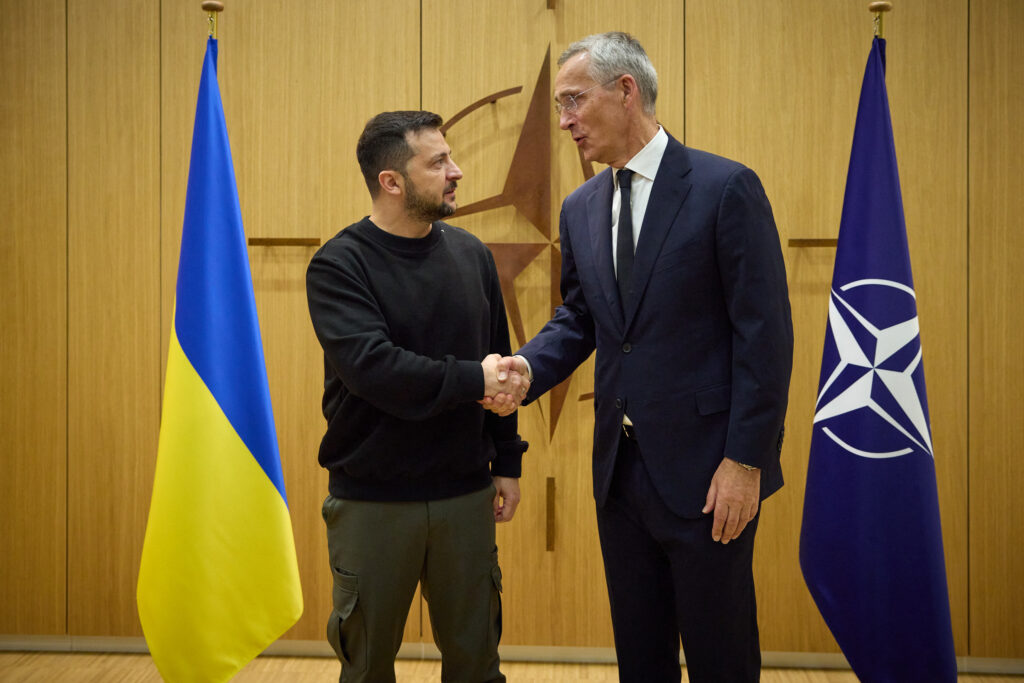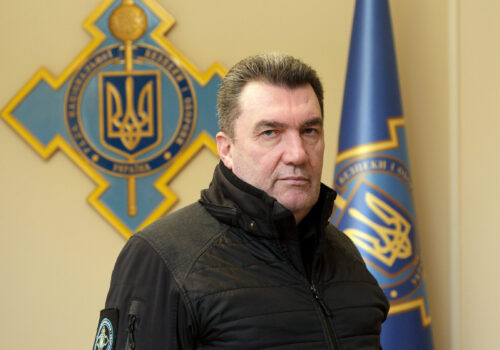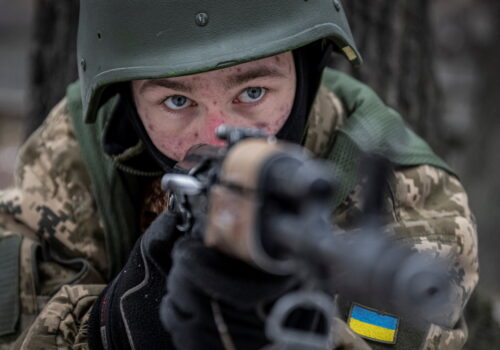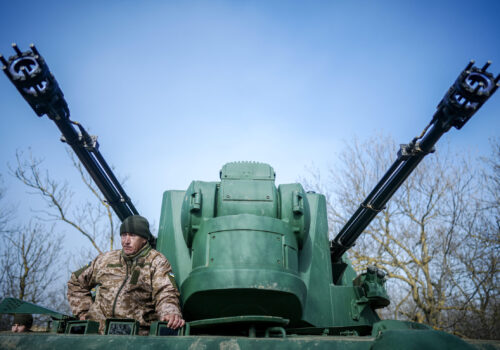French President Emmanuel Macron created shockwaves in Europe (again) recently, when he stated that “nothing should be excluded” when discussing the possibility of NATO troops on the ground in Ukraine.
Unsurprisingly, Germany had a different message: “Once again, in a very good debate, it was discussed that what was agreed from the outset among ourselves and with each other also applies to the future, namely that there will be no ground troops, no soldiers on Ukrainian soil sent there by European countries or NATO states,” German Chancellor Olaf Scholz said.
The sentiment from Berlin—no Western troops on the ground in Ukraine—was echoed in statements from the White House, and from London, Rome, Madrid, and other capitals. Yet in an interview on March 14, Macron declined again to rule out sending troops to Ukraine.
Macron has a point: the deployment of troops from NATO members in Ukraine—in noncombatant positions—should not be categorically ruled out. A future mission to train Ukrainian soldiers in Ukraine conducted by, for example, British or German troops might be possible. In some scenarios, it would be more efficient to bring instructors to Ukraine than to send Ukrainian troops to Germany or the United Kingdom. Similarly, as the French Foreign Minister Stéphane Séjourné has stated, tasks such as assisting with mine clearance, production of weapons, and cyber defense are all possible to envisage being done with direct Western help in Ukraine in the near future.
But what these discussions illustrate is NATO’s internal discord when it comes to Ukraine. This discord was present in the run-up to the Vilnius NATO Summit last year, and the same tendencies are beginning to arise yet again. Some countries, most notably the Baltics, Poland, and France, want to provide Ukraine with a clear roadmap toward NATO membership. This will require more—and more direct—NATO involvement in Ukraine. Others, led by the United States and Germany, want to take a more cautious approach and do not wish to promise too much to Ukraine too early.
Ensuring Ukraine prevails on the battlefield will be imperative to securing the European continent.
The current front-runner to become the next NATO secretary general, Dutch Prime Minister Mark Rutte, stated at the Munich Security Conference in February that “as long as the war is raging, Ukraine cannot become a member of NATO.” This statement is just as unwise and short-sighted as Scholz’s denial of the possibility of a NATO presence in Ukraine. What Rutte is in effect saying to Russian President Vladimir Putin is that as long as Russia keeps the war warm, it will prevent Ukraine from becoming a NATO member. It provides Putin with an incentive to keep the war going, and in practice an indefinite veto power over NATO enlargement, just as he had in the years after Russia’s annexation of Crimea in 2014.
Ensuring Ukraine prevails on the battlefield will be imperative to securing the European continent. It is time for NATO to get smarter about its Ukraine strategy, including the messaging that articulates that strategy. At the moment, NATO and its constituent members are attempting to walk the line between reassuring Ukraine of NATO countries’ commitments to its security and seeking to avoid escalation into a nuclear confrontation with Russia. Avoiding such escalation is a legitimate concern, but it is not enough to constitute a strategy.
What NATO should do instead is steadily build defense and deterrence against Russian aggression in Ukraine by integrating it into its structures step by step. This will mean some degree of Ukrainian integration with NATO, even while Russia’s invasion is ongoing. This is where new and creative thinking is needed.
NATO can allow for functional integration, or, to repurpose a term from the European Union enlargement literature: differentiated integration. By beginning in certain sectors, such as cybersecurity, air defense, logistics, training, and future force design, NATO could engage with Ukraine without embarking yet on full integration. This is already happening to some extent, but often in a bilateral manner rather than from within a NATO framework. NATO can also take over several of the tasks which today are coordinated in the US-led Ukraine Defense Contact Group. Lastly, NATO can also begin to think in geographical terms. Maybe not all Ukrainian territory needs to be covered under Article 5 right away, but perhaps some of the westernmost regions?
It’s possible NATO could even commit forces to operating within Ukraine while still avoiding a direct fight with Russia. If, for instance, NATO declared a no-fly zone in parts of Ukraine and deployed air defense systems to assist Ukrainian defense in this region, then these systems could be limited to shooting down incoming missiles. They do not need to target the Russian planes firing the missiles from inside Russia. This is a much riskier step than providing training, of course, but it is not unimaginable.
Deterrence is sometimes most effective if it is ambiguous. When an adversary is uncertain about where the red lines are, then it might act more cautiously than if it knows the exact threshold it can escalate up to without crossing. Ambiguity also provides allies with a greater degree of flexibility about a response. NATO has, for example, declared that cyberattacks are covered by Article 5, but it has never stated exactly how serious such an attack must be for the allies to invoke the article. Going forward, if NATO allies wanted to create a greater degree of ambiguity about whether troops would be sent to Ukraine, amplifying Macron’s recent statement, then it might affect how far Russia carries out its invasion.
However, on the physical battlefield, where forces clash, deterrence cannot be ambiguous. A Russian tank crossing the Finnish border would be grounds to invoke the North Atlantic Treaty’s Article 5, which accords with Article 51 in the United Nations Charter permitting collective defense against an armed attack. The same applies if a Russian Iskander missile hits Warsaw. NATO’s future collective defense of Ukraine should be similarly explicit and clearly communicated to Moscow. There must be lines that Russia cannot cross. This is risky, but there is no risk-free way of bringing Ukraine into NATO.
Unlike the Alliance’s disjointed approach to the security and defense of Ukraine, differentiated integration is the strategy the Alliance needs to continue bringing Ukraine into its orbit while signaling unity in the lead-up to the milestone summit in July.
Whether intended or not, Macron may have set in motion an important conversation about Ukrainian defense integration. Western leaders and policymakers should continue and build on that conversation as the NATO Summit in Washington approaches. Ukraine needs a clear plan for differentiated integration—in terms of function and space—even as the war rages on.
The alternative hands Putin the power to veto the future of Ukraine as a free and sovereign state.
Karsten Friis is a research professor focusing on security and defense at the Norwegian Institute of International Affairs.
Further reading
Thu, Mar 14, 2024
Ukraine’s Security Council Secretary: The West is still in denial over Russia
UkraineAlert By Peter Dickinson
Western leaders have yet to grasp the true scale of the threat posed by Putin's Russia and are in danger of suffering an history defeat, warns the Secretary of Ukraine's Security and Defense Council Oleksiy Danilov.
Fri, Mar 15, 2024
Help Ukraine win—or risk kicking off a US losing streak
New Atlanticist By Tod D. Wolters, Ann Marie Dailey
Supporting Ukraine isn’t charity. It is a way for the United States to reassert itself at a time when its influence is faltering.
Thu, Mar 14, 2024
Peace is impossible until Ukraine is safe from future Russian aggression
UkraineAlert By
With Russia openly committed to destroying the Ukrainian state and nation, a durable peace will only prove possible once Ukraine's national security is guaranteed, writes Mykola Bielieskov.
Image: Handout photo shows Ukrainian president Volodymyr Zelensky and Nato secretary general Jens Stoltenberg shake hands at the start of Zelensky’s first visit to NATO's headquarters since the start of Russia's invasion of Ukraine in February 2022. Brussels, Belgium, October 10, 2023.



